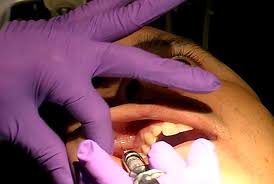Topical anesthetic is widely used to prepared the injecton site and is recommended to decrease pain. The effectiveness of intraoral topical anesthetics with different formulations and concentrations in reducing injection pain have been documented by multiple studies. The results of other studies have shown that the benefit of using topical anesthetic is inconclusive when it is compared with placebos or other methods.
The effectiveness of other alternatives such as applying pressure to the injection site and vibrating the surrounding tissue while administering the injection, however, is limited. The use of a mechanical anesthetic delivery system is effective, but it has a slower anesthetic application time and higher cost of equipment than does an injection with a syringe.
The use of a refrigerant such as ice stick and a refrigerant spray to reduce the pain experienced during administration of a maxillary palatal injection has been described in technique articles in the dental literature. Refrigerant spray could contain dichlorodifluoromethane, 1,1,1,3,3-pentafluoropropane, or 1,1,1,2 tetrafluoroethane.
In their study, Dr. Kosaraju and Dr. Vandewalle try to determine the effectiveness of a refrigerant compared with that of a topical anesthetic gel in reducing the pain experienced during a posterior palatal anesthetic injection.
Sixteen participants received a five-second application of a refrigerant (1,1,1,3,3-pentafluoropropane/1,1,1,2-tetrafluoroethane) and a two-minute application of a topical anesthetic gel (20 percent benzocaine gel) in the posterior palatal area before an injection of a local anesthetic solution was administered with a 30-gauge needle. Participants rated the pain they experienced after each injection by using a 100-millimeter visual analog scale (VAS) with endpoints of "no pain" and "worst possible pain." The authors calculated VAS scores by measuring the distance in millimeters from the no pain end of the scale. They analyzed data with a paired t test ({alpha} = .05).
From the result, they found that the use of a refrigerant as a preinjection anesthetic was more effective compared with the use of a topical anesthetic gel in reducing the pain experienced by participants who received a posterior palatal injection. Decreased application time and ease of application could be another benefit from refrigerant compared to topical anesthetic.
Source:
Kosaraju, A; and Vandewalle, K.S. 2009. A Comparison of a Refrigerant and a Topical Anesthetic Gel as Preinjection Anesthetics. J Am Dent Assoc, 140(1): 68-72.
The effectiveness of other alternatives such as applying pressure to the injection site and vibrating the surrounding tissue while administering the injection, however, is limited. The use of a mechanical anesthetic delivery system is effective, but it has a slower anesthetic application time and higher cost of equipment than does an injection with a syringe.
The use of a refrigerant such as ice stick and a refrigerant spray to reduce the pain experienced during administration of a maxillary palatal injection has been described in technique articles in the dental literature. Refrigerant spray could contain dichlorodifluoromethane, 1,1,1,3,3-pentafluoropropane, or 1,1,1,2 tetrafluoroethane.
In their study, Dr. Kosaraju and Dr. Vandewalle try to determine the effectiveness of a refrigerant compared with that of a topical anesthetic gel in reducing the pain experienced during a posterior palatal anesthetic injection.
Sixteen participants received a five-second application of a refrigerant (1,1,1,3,3-pentafluoropropane/1,1,1,2-tetrafluoroethane) and a two-minute application of a topical anesthetic gel (20 percent benzocaine gel) in the posterior palatal area before an injection of a local anesthetic solution was administered with a 30-gauge needle. Participants rated the pain they experienced after each injection by using a 100-millimeter visual analog scale (VAS) with endpoints of "no pain" and "worst possible pain." The authors calculated VAS scores by measuring the distance in millimeters from the no pain end of the scale. They analyzed data with a paired t test ({alpha} = .05).
From the result, they found that the use of a refrigerant as a preinjection anesthetic was more effective compared with the use of a topical anesthetic gel in reducing the pain experienced by participants who received a posterior palatal injection. Decreased application time and ease of application could be another benefit from refrigerant compared to topical anesthetic.
Source:
Kosaraju, A; and Vandewalle, K.S. 2009. A Comparison of a Refrigerant and a Topical Anesthetic Gel as Preinjection Anesthetics. J Am Dent Assoc, 140(1): 68-72.




 Preinjection Anesthetics Comparisson Between Refrigerant and Topical Anesthetic Gel
Preinjection Anesthetics Comparisson Between Refrigerant and Topical Anesthetic Gel


gilang, refrigerant yg dimaksud dsini tuwh bs termasuk si chloretil ga siyh...??
kayaknya bisa sayur asem...
malah katanya bisa juga pake ice stick...